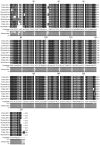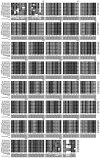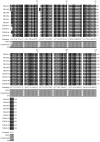The influence of genetic polymorphisms in TLR4 and TIRAP, and their expression levels in peripheral blood, on susceptibility to sepsis
- PMID: 26889229
- PMCID: PMC4726872
- DOI: 10.3892/etm.2015.2884
The influence of genetic polymorphisms in TLR4 and TIRAP, and their expression levels in peripheral blood, on susceptibility to sepsis
Abstract
The present study aimed to investigate whether genetic polymorphisms in the Toll-like receptor (TLR)-4 and Toll/interleukin-1 receptor (TIR)-associated protein (TIRAP) genes, and/or their expression levels, influence the susceptibility of a patient to sepsis. A total of 106 patients with sepsis were divided into two groups on the basis of their acute physiology and chronic health evaluation (APACHE) II scores: i) Sepsis group A (APACHE II <20) and ii) Sepsis group B (APACHE II >20). In addition, 100 healthy volunteers were enrolled into the control group. Polymerase chain reaction-restriction fragment length polymorphism assay was used to detect the following genetic polymorphisms: The Ser180Leu allele of the TIRAP gene and the Asp299Gly and Thr399I1e alleles of the TLR4 gene. Furthermore, the protein expression levels of TLR4 and TIRAP were analyzed using an enzyme-linked immunosorbent assay. Genetic polymorphisms were not detected for the TLR4 and TIRAP genes; however, the protein expression levels of TLR4 and TIRAP differed significantly between the control, sepsis A and sepsis B groups (P<0.01). An APACHE II score of 20 was used as a baseline in order to differentiate sepsis severity. Pearson analysis demonstrated that TLR4 and TIRAP protein expression levels were positively correlated with sepsis severity (r=0.931 and 0.972; P<0.05), and TLR4 protein expression levels were positively correlated with those of TIRAP (r=0.936; P<0.05). The results of the present study suggested that the protein expression levels of, but not genetic polymorphisms in, TLR4 and TIRAP were associated with the severity of sepsis.
Keywords: Toll-like receptor 4; Toll/interleukin-1 receptor-associated protein; genetic polymorphisms; sepsis.
Figures






Similar articles
-
Role of polymorphisms of toll-like receptor (TLR) 4, TLR9, toll-interleukin 1 receptor domain containing adaptor protein (TIRAP) and FCGR2A genes in malaria susceptibility and severity in Burundian children.Malar J. 2012 Jun 12;11:196. doi: 10.1186/1475-2875-11-196. Malar J. 2012. PMID: 22691414 Free PMC article.
-
Association of TLR4 (D299G, T399I), TLR9 -1486T>C, TIRAP S180L and TNF-α promoter (-1031, -863, -857) polymorphisms with risk for systemic lupus erythematosus among South Indians.Lupus. 2015 Jan;24(1):50-7. doi: 10.1177/0961203314549792. Epub 2014 Sep 2. Lupus. 2015. PMID: 25182168
-
Toll-like receptor and TIRAP gene polymorphisms in pulmonary tuberculosis patients of South India.Tuberculosis (Edinb). 2010 Sep;90(5):306-10. doi: 10.1016/j.tube.2010.08.001. Epub 2010 Aug 24. Tuberculosis (Edinb). 2010. PMID: 20797905
-
Association of TLR1, TLR2, TLR4, TLR6, and TIRAP polymorphisms with disease susceptibility.Immunol Res. 2015 Jun;62(2):234-52. doi: 10.1007/s12026-015-8640-6. Immunol Res. 2015. PMID: 25784622 Review.
-
Genetic polymorphisms associated with sepsis incidence, severity, and outcomes among neonates: A mini-review.J Adv Pharm Technol Res. 2023 Oct-Dec;14(4):289-293. doi: 10.4103/JAPTR.JAPTR_332_23. Epub 2023 Oct 30. J Adv Pharm Technol Res. 2023. PMID: 38107458 Free PMC article. Review.
Cited by
-
Comprehensive Evaluation of Lipopolysaccharide-Induced Changes in Rats Based on Metabolomics.J Inflamm Res. 2020 Aug 24;13:477-486. doi: 10.2147/JIR.S266012. eCollection 2020. J Inflamm Res. 2020. PMID: 32904659 Free PMC article.
-
Sesamin attenuates intestinal injury in sepsis via the HMGB1/TLR4/IL-33 signalling pathway.Pharm Biol. 2020 Dec;58(1):898-904. doi: 10.1080/13880209.2020.1787469. Pharm Biol. 2020. PMID: 32893702 Free PMC article.
-
Protective Effect of Baicalin Against TLR4-mediated UVA-induced Skin Inflammation.Photochem Photobiol. 2019 Mar;95(2):605-611. doi: 10.1111/php.13021. Epub 2018 Oct 14. Photochem Photobiol. 2019. PMID: 30246296 Free PMC article.
-
TIRAP Rs8177376, Rs611953, Rs3802814, and Rs8177374 Polymorphisms and Their Association with Cervical Cancer Phenotype and Prognosis.Genes (Basel). 2022 Jul 29;13(8):1365. doi: 10.3390/genes13081365. Genes (Basel). 2022. PMID: 36011276 Free PMC article.
-
Association between innate immunity gene polymorphisms and neonatal sepsis development: a systematic review and meta-analysis.World J Pediatr. 2022 Oct;18(10):654-670. doi: 10.1007/s12519-022-00569-7. Epub 2022 Jun 6. World J Pediatr. 2022. PMID: 35666457
References
LinkOut - more resources
Full Text Sources
Other Literature Sources
